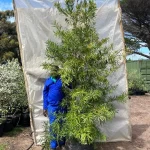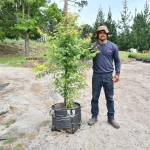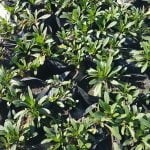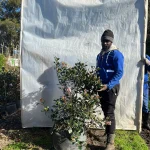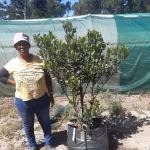Showing 1429–1440 of 2351 resultsSorted by popularity

Afrocarpus Latifolius 70lt
R2,450.00Add to cartAfrocarpus Latifolius 70lt
Common Name: Yellowwood TreeAfrocarpus latifolius, commonly known as “Yellowwood” or “Broad-Leaved Yellowwood,” is a large evergreen tree native to southern Africa. Here’s some information about it:
Yellowwood is a majestic tree that can reach heights of up to 40 meters. It features dense, glossy green foliage with broad, lance-shaped leaves. Female trees produce attractive fleshy, greenish-yellow fruit.
Climate and Habitat
Native to the forests and woodlands of southern Africa.
Thrives in temperate to subtropical climates.Sunlight
Prefers full sun to partial shade.
Can tolerate a range of light conditions but typically grows best in areas with good sunlight exposure.Soil
Thrives in well-draining, fertile soils.
Prefers slightly acidic to neutral soils.Watering
Requires regular watering, especially during dry periods and while establishing.
Once established, it can tolerate mild drought conditions.Temperature
Generally hardy in a range of temperatures, but protection from extreme cold may be necessary in colder regions.Pruning
Pruning is minimal and should be done to remove dead or diseased branches and maintain a healthy shape.Fertilisation
Fertilise in spring with a balanced, slow-release fertiliser to promote healthy growth.Pests and Diseases
Generally resistant to pests and diseases.
Proper care and spacing can help prevent issues.Landscaping Use
Often used as an ornamental and shade tree in larger gardens, parks, and estates.
Acer Palmatum 70lt
R4,450.00Add to cartAcer Palmatum 70lt (Green)
Acer palmatum, the Japanese Maple, is a popular ornamental tree valued for its stunning foliage, graceful form, and wide range of cultivars.
Japanese Maple is a deciduous tree known for its delicate, palmate (hand-shaped) leaves. Leaves come in a variety of colors including green, red, purple, and variegated combinations.
Depending on the cultivar, it can range in size from small shrubs to medium-sized trees.Climate and Hardiness
Prefers temperate to cool climates.
Different cultivars have varying levels of cold hardiness, so choose one appropriate for your climate zone.Sunlight
Partial shade to full sun is ideal, with protection from intense afternoon sun in hot regions.
Some red-leafed varieties may show better color in more sun.Soil
Well-draining, slightly acidic soil is preferred.
Amending the soil with organic matter can help with moisture retention.Watering
Regular watering, especially during dry periods and while the tree is establishing its root system.
Mulching can help retain moisture.Temperature
Protect young trees from extreme cold and harsh winds.
Some varieties may be more sensitive to cold than others.Pruning
Pruning is done to maintain shape, remove dead or diseased branches, and improve air circulation.
Best time for major pruning is during the dormant season (late autumn to winter).Fertilisation
Fertilise in spring with a balanced, slow-release fertiliser to support growth.Pests and Diseases
Watch out for aphids, scale insects, and caterpillars.
Proper spacing and good air circulation can help prevent fungal issues.Landscaping Use
Japanese Maples are often used as focal points in gardens due to their vibrant foliage.
Suitable for both container and in-ground planting.

Abelia Grandiflora 70lt
R2,450.00Add to cartAbelia Grandiflora 70lt
Full Sun
Semi Shade
Moderate WateringClimate
Suitable for a variety of climates, including temperate and subtropical regions.Sunlight
Thrives in full sun to light shade.
Prefers at least 4-6 hours of direct sunlight daily for optimal flowering.Soil
Well-draining soil is essential to prevent waterlogging.
Tolerant of a range of soil types, but prefers slightly acidic to neutral soils.Watering
Requires regular watering, especially during the establishment phase.
Once established, it can tolerate mild drought, but consistent moisture promotes better growth and flowering.Temperature
Generally hardy in mild to moderately cold temperatures.
Young plants might benefit from protection against severe cold.Fertilisation
Apply a balanced, slow-release fertiliser in spring to support growth and flowering.Pruning
Prune in late winter or early spring to shape the plant and encourage new growth.
Deadheading spent flowers can promote additional blooming.Pests and Diseases
Generally resistant to pests and diseases, but keep an eye out for aphids and scale insects.Spacing
Space plants adequately to allow for good air circulation, typically around 3-4 feet apart.Mulching
Apply a layer of mulch around the base of the plant to conserve moisture and control weeds.Wildlife Attraction
Attracts pollinators like bees and butterflies with its fragrant flowers.

- Sale!

Shasta Daisy 15cm Pot
Original price was: R85.00.R65.00Current price is: R65.00.Add to cartShasta Daisy 15cm Pot
Full Sun
Afternoon Sun
Moderate Watering
EvergreenThe Shasta daisy (Leucanthemum × superbum) is a popular perennial flower known for its classic white petals and yellow centres.
Appearance: Shasta daisies typically have large, showy, white flowers with yellow centres. The petals are often broad and radiate outward from the centre, giving the flower a classic daisy appearance. The flowers can reach a diameter of 7.5 to 10cm.
Growth: They are perennial plants, meaning they come back year after year when given proper care. Shasta daisies form clumps and can grow to a height of 60 to 90cm and spread about 30 to 60cm.
Blooming season: Shasta daisies typically bloom in late spring to early summer and sometimes continue to produce flowers through the summer, depending on the climate.
Sunlight and soil requirements: Shasta daisies prefer full sun but can tolerate partial shade. They thrive in well-draining soil that is rich in organic matter.
Maintenance: These daisies are relatively low-maintenance plants. Regular watering and deadheading (removing faded flowers) can encourage continuous blooming and help keep the plant tidy.
Hardy: Shasta daisies are hardy plants that can withstand a variety of weather conditions, making them suitable for many gardens.
Attracts pollinators: The flowers of Shasta daisies are attractive to bees, butterflies, and other pollinators, making them a great addition to pollinator-friendly gardens.
Uses: Shasta daisies are commonly used as ornamental garden plants, adding a touch of classic beauty to landscapes, flower beds, and borders.

Raphiolepis Indica Alba 70lt
R2,450.00Add to cartRaphiolepis Indica Alba 70lt
Full Sun
Semi Shade
Wind Tolerant
Low Watering
EvergreenRaphiolepis is a genus of evergreen shrubs and small trees in the family Rosaceae. The plants in this genus are commonly known as Indian Hawthorns or Yeddo Hawthorns. Raphiolepis species are native to East Asia, including regions in Japan, Korea, and China.
These plants are popular ornamental choices in gardens and landscapes due to their attractive features, including:
Flowers: Raphiolepis plants produce clusters of small, star-shaped flowers in various colours, such as white, pink, or red. The flowers typically have a pleasant fragrance.
Foliage: The foliage of Raphiolepis is usually glossy and evergreen, providing year-round greenery to the landscape.
Berries: After flowering, some Raphiolepis species produce small, dark berries, adding further ornamental interest to the plants.
Size and Shape: Depending on the species and cultivar, Raphiolepis can vary in size from compact shrubs to small trees. They have a rounded or vase-shaped growth habit.
Drought Tolerance: Raphiolepis is generally known for its tolerance to drought conditions, making it suitable for various climates.
Commonly cultivated species and cultivars within the Raphiolepis genus include:
Raphiolepis indica (Indian Hawthorn): One of the most popular species, it has pink or white flowers and is widely used in landscaping.
Raphiolepis umbellata (Yeddo Hawthorn): Another commonly grown species with white or pink flowers and glossy leaves.
Raphiolepis delacourii Light Pink 70lt
R2,450.00Add to cartRaphiolepis delacourii Light Pink 70lt
Full Sun
Semi Shade
Wind Tolerant
Low Watering
EvergreenRaphiolepis is a genus of evergreen shrubs and small trees in the family Rosaceae. The plants in this genus are commonly known as Indian Hawthorns or Yeddo Hawthorns. Raphiolepis species are native to East Asia, including regions in Japan, Korea, and China.
These plants are popular ornamental choices in gardens and landscapes due to their attractive features, including:
Flowers: Raphiolepis plants produce clusters of small, star-shaped flowers in various colours, such as white, pink, or red. The flowers typically have a pleasant fragrance.
Foliage: The foliage of Raphiolepis is usually glossy and evergreen, providing year-round greenery to the landscape.
Berries: After flowering, some Raphiolepis species produce small, dark berries, adding further ornamental interest to the plants.
Size and Shape: Depending on the species and cultivar, Raphiolepis can vary in size from compact shrubs to small trees. They have a rounded or vase-shaped growth habit.
Drought Tolerance: Raphiolepis is generally known for its tolerance to drought conditions, making it suitable for various climates.
Commonly cultivated species and cultivars within the Raphiolepis genus include:
Raphiolepis indica (Indian Hawthorn): One of the most popular species, it has pink or white flowers and is widely used in landscaping.
Raphiolepis umbellata (Yeddo Hawthorn): Another commonly grown species with white or pink flowers and glossy leaves.
Raphiolepis Delacourii Dark pink 70lt
R2,450.00Add to cartRaphiolepis Delacourii Dark pink 70lt
Full Sun
Semi Shade
Wind Tolerant
Low Watering
EvergreenRaphiolepis is a genus of evergreen shrubs and small trees in the family Rosaceae. The plants in this genus are commonly known as Indian Hawthorns or Yeddo Hawthorns. Raphiolepis species are native to East Asia, including regions in Japan, Korea, and China.
These plants are popular ornamental choices in gardens and landscapes due to their attractive features, including:
Flowers: Raphiolepis plants produce clusters of small, star-shaped flowers in various colours, such as white, pink, or red. The flowers typically have a pleasant fragrance.
Foliage: The foliage of Raphiolepis is usually glossy and evergreen, providing year-round greenery to the landscape.
Berries: After flowering, some Raphiolepis species produce small, dark berries, adding further ornamental interest to the plants.
Size and Shape: Depending on the species and cultivar, Raphiolepis can vary in size from compact shrubs to small trees. They have a rounded or vase-shaped growth habit.
Drought Tolerance: Raphiolepis is generally known for its tolerance to drought conditions, making it suitable for various climates.
Commonly cultivated species and cultivars within the Raphiolepis genus include:
Raphiolepis indica (Indian Hawthorn): One of the most popular species, it has pink or white flowers and is widely used in landscaping.
Raphiolepis umbellata (Yeddo Hawthorn): Another commonly grown species with white or pink flowers and glossy leaves.
Rhaphiolepis Umbellata White 50lt
R950.00Add to cartRhaphiolepis Umbellata White 50lt
Full Sun
Semi Shade
Wind Tolerant
Low Watering
EvergreenRaphiolepis is a genus of evergreen shrubs and small trees in the family Rosaceae. The plants in this genus are commonly known as Indian Hawthorns or Yeddo Hawthorns. Raphiolepis species are native to East Asia, including regions in Japan, Korea, and China.
These plants are popular ornamental choices in gardens and landscapes due to their attractive features, including:
Flowers: Raphiolepis plants produce clusters of small, star-shaped flowers in various colours, such as white, pink, or red. The flowers typically have a pleasant fragrance.
Foliage: The foliage of Raphiolepis is usually glossy and evergreen, providing year-round greenery to the landscape.
Berries: After flowering, some Raphiolepis species produce small, dark berries, adding further ornamental interest to the plants.
Size and Shape: Depending on the species and cultivar, Raphiolepis can vary in size from compact shrubs to small trees. They have a rounded or vase-shaped growth habit.
Drought Tolerance: Raphiolepis is generally known for its tolerance to drought conditions, making it suitable for various climates.
Commonly cultivated species and cultivars within the Raphiolepis genus include:
Raphiolepis indica (Indian Hawthorn): One of the most popular species, it has pink or white flowers and is widely used in landscaping.
Raphiolepis umbellata (Yeddo Hawthorn): Another commonly grown species with white or pink flowers and glossy leaves.
Rhaphiolepis Kruschenii White 50lt
R950.00Add to cartRhaphiolepis Kruschenii White 50lt
Full Sun
Semi Shade
Wind Tolerant
Low Watering
EvergreenRaphiolepis is a genus of evergreen shrubs and small trees in the family Rosaceae. The plants in this genus are commonly known as Indian Hawthorns or Yeddo Hawthorns. Raphiolepis species are native to East Asia, including regions in Japan, Korea, and China.
These plants are popular ornamental choices in gardens and landscapes due to their attractive features, including:
Flowers: Raphiolepis plants produce clusters of small, star-shaped flowers in various colours, such as white, pink, or red. The flowers typically have a pleasant fragrance.
Foliage: The foliage of Raphiolepis is usually glossy and evergreen, providing year-round greenery to the landscape.
Berries: After flowering, some Raphiolepis species produce small, dark berries, adding further ornamental interest to the plants.
Size and Shape: Depending on the species and cultivar, Raphiolepis can vary in size from compact shrubs to small trees. They have a rounded or vase-shaped growth habit.
Drought Tolerance: Raphiolepis is generally known for its tolerance to drought conditions, making it suitable for various climates.
Commonly cultivated species and cultivars within the Raphiolepis genus include:
Raphiolepis indica (Indian Hawthorn): One of the most popular species, it has pink or white flowers and is widely used in landscaping.
Raphiolepis umbellata (Yeddo Hawthorn): Another commonly grown species with white or pink flowers and glossy leaves.

